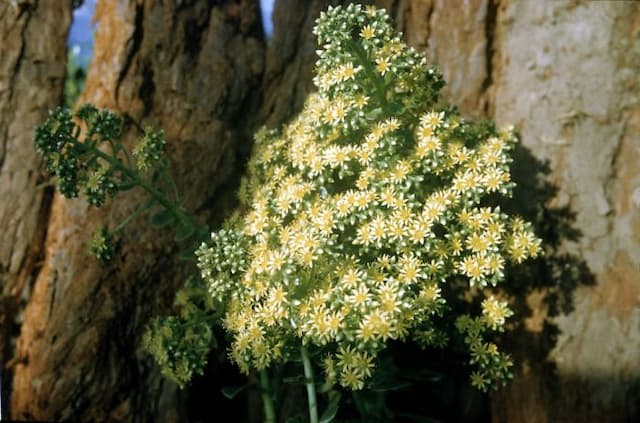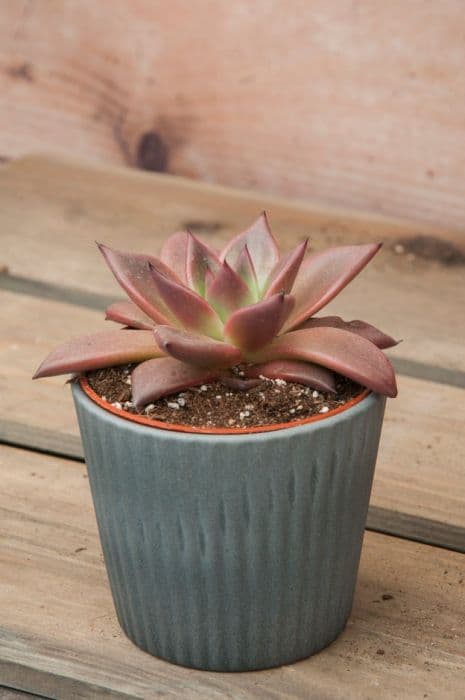Metallic Echeveria Echeveria gibbiflora 'Metallica'

ABOUT
Echeveria 'Metallica' is a succulent with a rosette-forming habit, showcasing a symmetrical arrangement of fleshy leaves. The leaves are broad at the base and taper to a point, often revealing subtle curves that contribute to the plant's sculptural quality. They are known for their distinctive metallic sheen, which gives the plant its common name. This sheen provides a shimmering effect, with colors ranging from a soft, silvery-green to a deeper hue that can even appear to have pinkish or purplish undertones, depending on light conditions. The edges of the leaves may be lined with a delicate blush coloring, which enhances the metallic look. Echeveria 'Metallica' produces bell-shaped, vibrant pink-orange flowers on tall stalks that emerge from the rosette center, adding a splash of color above the foliage. The overall aesthetic of the plant is one of structured elegance, with its compact form and distinctive shimmery leaves making it a popular choice for succulent collections and decorative arrangements.
About this plant
 Names
NamesFamily
Crassulaceae.
Synonyms
Metallic Echeveria, Silver Echeveria, Echeveria 'Metallica'.
Common names
Echeveria gibbiflora 'Metallica'.
 Toxicity
ToxicityTo humans
Echeveria, the most common common name for Echeveria gibbiflora 'Metallica', is generally considered non-toxic to humans. There are no commonly reported symptoms of poisoning from ingestion of this plant, as it is generally safe to handle and have in homes without concern for human health.
To pets
Echeveria is also generally considered non-toxic to pets. It should not cause any symptoms of poisoning if ingested by animals such as cats and dogs. Therefore, there are no specific consequences that are expected from pets ingesting any part of this plant. However, as with any non-food items, ingestion of large quantities could potentially cause a mild upset stomach or intestinal discomfort due to the foreign material, not because of toxicity.
 Characteristics
CharacteristicsLife cycle
Perennials
Foliage type
Evergreen
Color of leaves
Varies
Flower color
Red
Height
1 foot (30 cm)
Spread
1 foot (30 cm)
Plant type
Succulent
Hardiness zones
9
Native area
Mexico
Benefits
 General Benefits
General Benefits- Easy Care: Echeveria 'Metallica' is a low-maintenance plant, requiring minimal watering and care, which makes it ideal for beginners or those with busy lifestyles.
- Drought Tolerant: As a succulent, it has a high tolerance for drought conditions, making it a suitable choice for water-wise gardens.
- Decorative: With its rosette form and often colorful leaves, Echeveria 'Metallica' is an attractive addition to any indoor or outdoor plant collection.
- Promotes Humidity: Like other plants, it can help to increase humidity levels in a room, which can be beneficial during dry seasons or in arid climates.
- As a succulent, it's not often bothered by pests, making it a resilient and less troublesome option for gardeners.
 Medical Properties
Medical PropertiesThis plant is not used for medical purposes.
 Air-purifying Qualities
Air-purifying QualitiesThis plant is not specifically known for air purifying qualities.
 Other Uses
Other Uses- Echeveria Metallica can be used as a natural jewelry accent, such as in living plant earrings or necklaces, since the rosettes are attractive and resilient.
- Juvenile Echeveria Metallica rosettes can serve as adornment for wedding place settings, functioning as a unique, living memento for guests.
- For those practicing miniature gardening or creating fairy gardens, the small size of this plant can add a realistic and enchanting flair.
- They can be used in themed terrariums, especially in settings that represent arid or desert environments, to add authenticity to the miniature landscape.
- In artistic projects, such as living sculptures, Echeveria Metallica provides texture and form, harmonizing with both organic and metallic materials.
- When combined with other succulents, Echeveria Metallica can be utilized in living wall installations, contributing to unique patterns and designs.
- Echeveria Metallica's drought tolerance makes it suitable for xeriscaping, reducing water usage in landscapes particularly in arid climates.
- This plant can be used as a tool for education – teaching children about plant care, propagation, and succulent species diversity.
- In culinary presentations, though not edible, Echeveria Metallica can serve as an eye-catching, non-toxic decoration on dining tables or as part of the plating aesthetics.
- Photographers and visual artists sometimes use Echeveria Metallica as a subject or backdrop due to its sculptural appearance and vibrant coloration, which contribute to an interesting visual composition.
Interesting Facts
 Feng Shui
Feng ShuiThe Echeveria is not used in Feng Shui practice.
 Zodiac Sign Compitability
Zodiac Sign CompitabilityThe Echeveria is not used in astrology practice.
 Plant Symbolism
Plant Symbolism- Perseverance: Echeveria gibbiflora 'Metallica', more commonly known as 'Metallica Echeveria', is a succulent that thrives in harsh conditions, symbolizing the ability to persist and thrive despite challenges.
- Beauty and Balance: With its symmetrical rosette shape and attractive metallic sheen, the Metallica Echeveria represents the harmony and beauty in nature, as well as the balance between form and function.
- Uniqueness: The distinct metallic appearance and unique coloration of this succulent serves as a symbol of individuality and standing out from the crowd.
- Love and Companionship: As a plant that often produces offsets or "pups", it can symbolize the growth of love and the development of new relationships that support and replicate the original beauty.
- Adaptability: The Metallica Echeveria's ability to adapt to various lighting conditions and require minimal care reflects the symbolic meaning of adaptability and ease of integration into different environments.
 Water
WaterThe Echeveria 'Metallica' should be watered thoroughly when the soil is completely dry, which typically means every 1 to 2 weeks, depending on the climate and season. Water directly at the base of the plant, avoiding the leaves, until you see excess water draining out of the bottom of the pot. In general, give the plant approximately 4 ounces of water per 6-inch pot during each watering session. It's vital not to let the plant sit in water, as this can lead to root rot. Always check the top inch of the soil before watering to ensure it is dry.
 Light
LightEcheveria 'Metallica' thrives in bright, indirect sunlight, making it an ideal plant for a spot that receives plenty of light without direct exposure to the harsh afternoon sun. A south or east-facing window is optimal for providing the best light conditions for healthy growth. However, ensure to protect it from the intense midday sun to prevent leaf burn.
 Temperature
TemperatureEcheveria 'Metallica' prefers a temperature range of 65 to 80 degrees Fahrenheit, but it can tolerate temperatures as low as 40 degrees and as high as 90 degrees Fahrenheit for short periods. The plant should be protected from frost and extreme heat, which means moving it indoors or to a shaded area when temperatures exceed its tolerance levels.
 Pruning
PruningPruning Echeveria 'Metallica' involves removing dead or damaged leaves to encourage healthy growth and maintain an attractive shape. Prune sparingly, only as needed, typically once or twice a year, preferably during the spring or early summer. The best time for pruning is when the plant is showing signs of new growth, indicating the beginning of its active growing season.
 Cleaning
CleaningAs needed
 Soil
SoilEcheveria, also known as Hens and Chicks, prefers a well-draining soil mix consisting of one part potting soil, one part perlite or coarse sand, and one part peat to maintain slight acidity with a pH of around 6.0. A succulent-specific mix also works well.
 Repotting
RepottingHens and Chicks should be repotted every two to three years or when it outgrows its container. Choose a pot only slightly larger than the current one to avoid excess soil moisture.
 Humidity & Misting
Humidity & MistingHens and Chicks thrive in a dry environment and prefer lower humidity levels, typically below 40%. High humidity should be avoided to prevent rot and fungal diseases.
 Suitable locations
Suitable locationsIndoor
Place Hens and Chicks in bright light away from drafts, water sparingly.
Outdoor
Plant Hens and Chicks in well-draining soil, full sun to partial shade.
Hardiness zone
9-11 USDA
 Life cycle
Life cycleEcheveria 'Metallica', commonly known as Silver Echeveria, begins its life cycle as a small seed, which when provided with adequate warmth and moisture, germinates into a seedling. The seedling then develops fleshy leaves in a rosette pattern characteristic of many succulent plants. As it matures, the rosette grows larger and may produce offsets, or "pups," around its base, which can be separated and planted to propagate new plants. During its growth period, the Silver Echeveria needs minimal water due to its drought-tolerant nature, and it prefers bright light conditions. Once it reaches maturity, it sends up a tall flower stalk with bell-shaped, red to pink flowers that attract pollinators and can lead to seed production if pollinated. After the plant flowers, which may take several years, it generally enters a period of dormancy before the cycle can begin anew with the next growing season.
 Propogation
PropogationPropogation time
Spring-Summer
Echeveria gibbiflora 'Metallica', commonly known as 'Metallic Echeveria', is best propagated during spring or early summer when the plant is actively growing. The most popular method of propagation for this succulent is through leaf cuttings. To propagate, gently twist a healthy leaf from the stem, ensuring that the entire base of the leaf is intact. Allow the leaf to callous over for a few days by placing it in indirect sunlight. Once the end has dried, place it on top of a well-draining cactus or succulent soil mix. In a few weeks, roots and a new plantlet should emerge from the base of the leaf. It's important to water sparingly at this stage to prevent rot, providing just enough moisture to keep the soil slightly damp.









